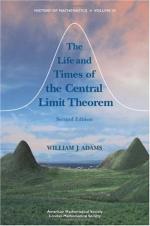|
This section contains 604 words (approx. 3 pages at 300 words per page) |

|
The central limit theorem is the name of a fundamental result in probability theory in which the so-called bell-shaped curve appears. Suppose, for example, that a fair coin is tossed N times. By a {\it fair} coin we understand an ideal coin in which the probability of getting heads is 1/2, and so the probability of getting tails is also 1/2. It is easy to compute the probability that after N tosses there will be exactly M heads, and so exactly N-M tails. When a fair coin is tossed N times we can record the outcomes as series of H's and T's. Thus after tossing a fair coin 10 times we might have an outcome such as T H H T T T H T H T. If we toss a coin N times the number of outcomes that contain exactly M heads is equal...
|
This section contains 604 words (approx. 3 pages at 300 words per page) |

|


